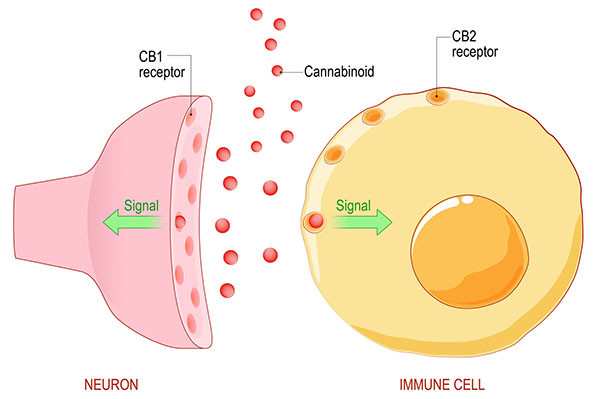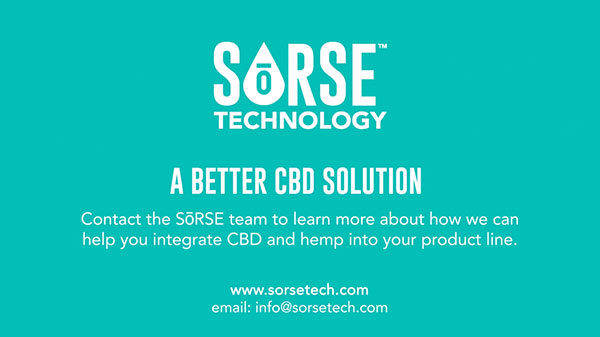When it comes to products featuring CBD, THC, and other cannabinoids, much has changed over the past ten years. From beverages to tinctures to topicals to edibles, there are a plethora of cannabinoid-infused products on the market today. As states continue to legalize medicinal and adult recreational cannabis use, the number of infused food and beverage items grows as well. Products are also featuring more of the minor cannabinoids like CBN, CBC, and CBG for their purported health benefits.
Learning about the Endocannabinoid System, a complex physiological system in the brain and body, is the first step for consumers who want to understand how products infused with CBD, THC, and other cannabinoids “work” after ingestion.
The Role of the Endocannabinoid System in the Human Brain and Body
The Endocannabinoid System is a unique molecular communications network that can have a wide range of effects on different body systems. This system regulates many important functions such as immune response, metabolism, appetite, and communication between cells. It appears that the main function of ECS is to establish and maintain bodily balance, known as homeostasis. Its purpose is to maintain a stable internal environment despite fluctuations and changes in the external environment. According to biochemist Vincenzo Di Marzo, the scientist who named the ECS, it oversees our processes of “eating, sleeping relaxing, forgetting, and protecting.”
Endocannabinoids and their receptors are found throughout the body: in the brain, organs, connective tissues, glands, and immune cells. In each tissue, the cannabinoid system performs different tasks, but the goal is always the same: balance through homeostasis. Cannabinoids promote homeostasis at every level of biological life, from the sub-cellular, to the organism, and perhaps to the community and beyond. All vertebrates produce endocannabinoids.
Much of our understanding of the ECS today is the result of seminal studies in the 80’s and 90’s that led to the discovery of the receptors and neurotransmitters in animal tissue.
The ECS’ Core Components
Endocannabinoids, their receptors, and enzymes are the three core components of the ECS.
Endocannabinoids
Endocannabinoids (aka endogenous cannabinoids) are molecules produced by the body. They are found at the intersection of various systems, allowing communication and coordination between different cell types. At the site of an injury, for example, cannabinoids can be found decreasing the release of activators and sensitizers from the injured tissue, stabilizing the nerve cell to prevent excessive firing, and calming nearby immune cells to prevent release of pro-inflammatory substances. These molecules help keep internal functions running smoothly. Your body produces them as needed, making it difficult to know what typical levels are for each.
- The two primary endocannabinoids that have been identified are anandamide (AEA) and 2-archidonoylgylerol (2-AG). The level of endocannabinoids in our body often fluctuates because our body produces them as needed.
Endocannabinoid Receptors
Endocannabinoid receptors are found throughout your body. Endocannabinoids bind to them, which signals that the ECS needs to take action.
There are two main receptors:
- CBR1 — predominantly found in the central nervous system
- CBR2 – predominantly found in the peripheral nervous system, especially immune cell.
Endocannabinoids can bind to either receptor. The effects of that depend on where the receptor is located and which endocannabinoid it binds to. For example, endocannabinoids might target CB1 receptors in a spinal nerve to relieve pain. Others might bind to a CB2 receptor in your immune cells to signal that your body’s experiencing inflammation, a common sign of autoimmune disorders.
Enzymes
Enzymes are responsible for breaking down endocannabinoids once they’ve carried out their function.
How Phytocannabinoids Interact with the ECS
Phytocannabinoids are the active chemical compounds found in the cannabis plant that interact with a human or animal’s body’s endocannabinoid receptors. CBD and THC are two of over 100+ different cannabinoids that reside in the flowers of the cannabis plant. After being consumed in the form of a beverage or edible, digested, and absorbed into the blood stream, the phytocannabinoids will attach to the receptors which will help maintain or re-establish that balance.
The more research that is conducted on the ECS and the ways that cannabinoids interact with the ECS receptors, the better we will understand the potential benefits CBD and other cannabinoids have on the human body.
Body Processes Linked to the ECS
Despite the fact that it is difficult to study the impact of the phytocannabinoids on the human body given regulatory hurdles, researchers are committed to pursuing the study of the plant. The goal for scientists is to better understand how cannabinoids can interact with the ECS to see how the following bodily processes might be impacted:
- Appetite
- Digestion
- Metabolism
- Chronic pain
- Inflammation
- Immune system responses
- Mood
- Learning and memory
- Motor control
- Sleep
- Cardiovascular function
- Bone development
- Muscle formation
- Bone growth
- Liver function
- Reproductive function
- Stress
- Skin and nerve function
The Different Ways THC & CBD Interact with the ECS
THC and CBD are the two most well-known cannabinoids in today’s marketplace, and they interact differently with the Endocannabinoid System. THC acts as a CB1 and CB2 agonist. An agonist is a chemical that activates a receptor to elicit a biological response. When THC binds to CBR1, it is activated, which causes a release of neurochemicals such as Dopamine; this is similar to the binding of endogenous cannabinoids to the receptor.
In contrast, CBD is an antagonist of these receptors and indirectly exhibits an opposite effect. This is part of the reason scientists theorize that CBD can counteract some of the effects of THC. It acts as a regulator of ion channels and non-cannabinoid receptors. When ligands bind to membrane proteins, ion channels are opened that permit ions to move through the channel pore such as Ca2+ and Na+. This can result in release of neurotransmitters, hormones, and a host of other cell-signaling pathways. CBD can also increase the activity of serotonin receptors and inhibit endocannabinoid reuptake.
Everyone’s ECS is unique and different, which means that no one person will have the exact same reaction after consuming any cannabinoid as someone else.
Closing Thoughts
For consumers to understand how cannabinoids impact how our brain and body functions, learning about the ECS as well as regularly documenting how one feels after ingesting cannabinoids is essential. It’s also important for them to look for high-quality products that have accurate label claims and have been lab tested, to ensure they are getting the cannabinoids they pay for. We and our Powered by SōRSE partners are committed to creating products that are safe, consistent, accurately dosed, and great-tasting, because cannabinoid consumers deserve just that.






